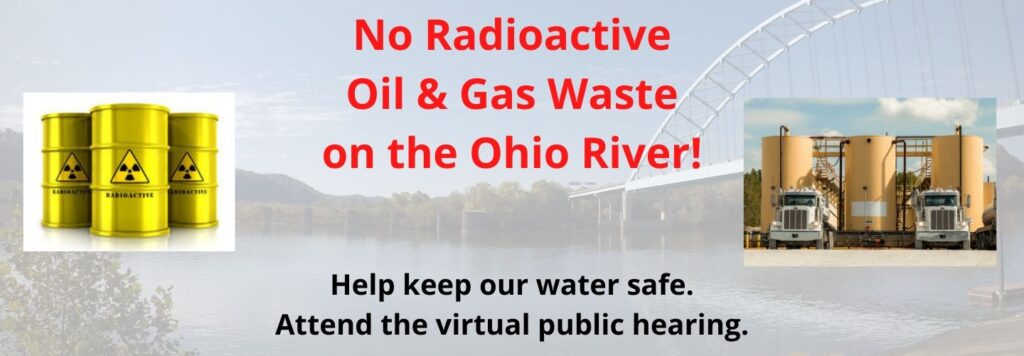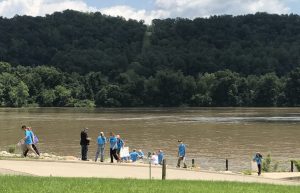
If the answer to the title question is “no!” then please register to attend the Peoples Hearing on August 27th
Why is this necessary?
A virtual hearing hosted by USACE on August 7th, 2020 didn’t provide good access and allow adequate time for all participants to voice their concerns, so we – the people – are holding our own public meeting!
Media reps covered the August 7th public meeting, but USACE officials wouldn’t even talk freely to them.
This Letter to the Editor of the Huntington Herald Dispatch gives some details.
What’s the big deal? There have been three barge docks proposed to be built along the Ohio side of the Ohio River this year. If built, all three will be accepting oil and gas waste from unknown destinations, some of which are likely to be connected to horizontal well “fracking” operations. This would put a host of highly toxic and potentially radioactive substances only one spill away from contaminating the tap water for five million people. So far, this is the only public meeting or hearing that has been granted in response to public requests and comments.
Please register for the virtual public meeting, and send comments or questions. If you need more information or advice, contact robin@ohvec.org
Particular details of the hearing:
- Relevant to the Deep Rock proposed barge facility near Marietta, OH.
- To register for this hearing and receive the meeting link and call-in information send an email to: CELRH.North@usace.army.mil with the subject line “RSVP for 7 August Public Meeting” and include your full name, email address, and contact phone number with area code.
- To submit a question prior to the meeting send an email to: CELRH.North@usace.army.mil with the subject line “Question for 7 August Public Meeting” and include your full name and contact phone number with area code. Questions submitted by email prior to the virtual public meeting will be prioritized over those received during the meeting, according to info. posted by USACE.
-
Comments and requests for additional information should be submitted electronically to CELRH.North@usace.army.mil by 4 p.m. August 17, 2020. If you do not have internet access, comments may be submitted through the U.S. Postal Service (USPS) to the following address:
United States Army Corps of Engineers
ATTN: CELRH-RD-N
Public Notice: LRH-2020-293-OHR
502 Eighth Street
Huntington, West Virginia 25701-2070
Here are some urgent concerns we have about these proposed barge dock facilities, which focus on pollution/spill response concerns:
It is unclear who would have jurisdiction/responsibility for records keeping and spill response planning, and whether those entities have clear channels of communication about the contents of these barges.
There is a lack of appropriate testing methods for radionuclides; some of this waste could be radioactive (especially if from the Marcellus and Utica shale fields).
USCG does not provide for any public notification, or public comment period, and only allows extremely limited access to public records on horizontal fracking related waste barges. USCG approves applications for this type of oil and gas waste based on information provided entirely by the shipper and waste can be sourced from hundreds of horizontal or vertical fracking wells in different phases of production throughout the Appalachian Basin.
Toxic contents of unconventional oil and gas drilling waste are not among the chemicals tested for at source water intakes, nor at ORSANCO testing stations. Common contaminants in fracking waste that are toxic to human health: chemical additives, such as ethylene glycol, naphthalene, and sulfuric acid; Metals and organic compounds – for example, barium is linked to gastrointestinal disturbances, muscle weakness, and paralysis; BTEX – benzene, toluene, ethylbenzene, xylene – for example, benzene is a carcinogen, and linked to blood disorders such as anemia, and toluene is
linked to nervous system, kidney, and liver problems; salts or total dissolved solids – corrodes infrastructure, harms aquatic life and vegetation; NORM – naturally occurring radioactive materials, such as radium-226 and radium-228 – carcinogenic, linked to blood disorders. (These isotopes are found in brine associated with the salt deposits in the Marcellus shale and are brought to the surface along with produced water during fracking).
Current drinking water treatment would probably be unable to filter out these contaminants if a spill occurred.
Current standards for chemicals in fracking fluids, such as toluene, benzene and xylenes – established over 30 years ago – are NOT adequate to protect human health. Fracking waste contain TENORM (Technically enhanced radioactive materials) that can contain water soluble radium 226 and 228 according to a March 20, 2020 EPA post, in 120 pCi/gram. These radionuclides can only be removed by osmosis and ion exchange
methods; neither technique is used by most public drinking water facilities in our region. (The EPA has set a legal limit for Radium 226 and 228 combined at 5 picocuries per liter)
Levels of radium could be much higher because of inadequate testing methods.
Here are more talking points, and sample questions that you might want to include in comments or questions sent to USACE:
Please register for the virtual Peoples Hearing on 8/27 . If you need more information or advice, contact robin@ohvec.org












How is the waste bring transported to Marietta, Oh? Will pipelines be run or will it be transported in tanker Tru ks which often leak?
1) It is already being trucked to the holding tanks and underground injection wells maintained by the Deep Rock corporation. These holding tanks are adjacent to Rt. 7 – just south of the Harmer Village area.
2) If this and two other barge dock facilities get approved/built, there will be an increase of barges on the Ohio River that are transporting massive quantities of this waste.
Also, we understand that there will be a need to transport the waste from the barges at the proposed Deep Rock facility to the holding tanks and underground injection well. Some of this may happen via pipeline – for short distances – but some may go by truck.